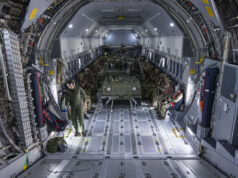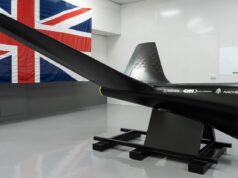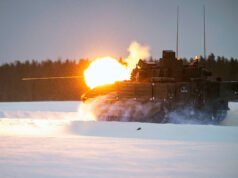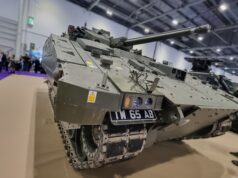The British Army is projected to take delivery of over 180 Ajax armoured vehicles by 31 December 2025, as part of the troubled Armoured Cavalry Programme, according to Defence Minister Maria Eagle.
In response to parliamentary questions from Ben Obese-Jecty MP, the Minister referred to a previous response from July 2024, reiterating that the programme remains on course to deliver the vehicles by the end of the year.
Eagle confirmed:
“The Armoured Cavalry Programme (Ajax) is projecting the delivery of over 180 operationally deployable platforms by the end of 2025.”
Despite numerous delays and technical challenges—including noise and vibration issues that resulted in a temporary halt to trials—Eagle’s response indicates that the programme is now progressing towards Initial Operating Capability (IOC).
While no firm date has been given for IOC, the MOD’s projection of over 180 delivered vehicles suggests that the Army is moving closer to integrating the Ajax platform into frontline service.
The £5.5 billion Ajax programme, originally intended to provide the Army with a cutting-edge reconnaissance and armoured fighting vehicle fleet, has faced significant delays, cost overruns, and design issues. The Army had expected to begin fielding Ajax in 2017, but extensive technical problems—including concerns over crew safety—pushed the project years behind schedule.
Despite this, the government has maintained that Ajax will play a vital role in modernising the British Army’s armoured capabilities, particularly as part of the Future Soldier transformation plan.
With the programme moving forward, the focus now shifts to whether Ajax can deliver the capability the Army originally envisioned, or whether further delays and modifications will be required before it reaches full operational deployment.
For now, the MOD’s latest figures suggest that, after years of setbacks, the British Army could finally begin receiving significant numbers of Ajax vehicles by the end of this year.














I am making a good salary from home $4580-$5240/week , which is amazing under a year ago I was jobless in a horrible economy. I thank God every day I was blessed with these instructions and now its my duty to pay it forward and share it with Everyone, Here is I started_______ work43.marketingℱ
please don’t copy”ℱ” In Url Thanks
Can you imagine making $18,000 a month while working from home just a few hours a day? I’m doing it, and I never thought it was possible until I found this online opportunity. The work is super easy, and you don’t need any prior experience—just a desire to succeed! I can’t believe how much my life has changed in such a short time. If you’re ready to take control of your income, visit the website and get started today!
Visit This…… 𝐖𝐰𝐰.𝐇𝐢𝐠𝐡𝐏𝐫𝐨𝐟𝐢𝐭𝟏.𝐂𝐨𝐦
Getting paid Every month more than $25,000 by doing very simple Online job from home.i m doing this job in my part time i have earned and received $25861 last month .I am now a good Online earner and earns enough cash for my needs. Every person can get this Online job.follow details on this website…..
Go Here——➤ 𝗪𝘄𝘄.𝗪𝗼𝗿𝗸𝘀𝗣𝗿𝗼𝗳𝗶𝘁𝟳.𝗖𝗼𝗺
I just received $6618 working off my Iaptop this month. And if you think that’s cool, my divorced friend has twin toddlers and made 0ver $15781 her first m0nth. It feels so good making so much money when other people have to work for so much less.
This is what I do…… work43.marketingℱ
please don’t copy”ℱ” In Url Thanks
Do 180 count as ‘significant numbers’
Oliver, We are buying 589 AJAX and variants; 180 is just the initial tranche that is delivered this calendar year.
So what’s the longer term order book for Merthyr Tydfil, a 40mm Ares IFV?
There’s a whole raft of potential platforms that can be developed from AJAX, the only constraint is the will from MOD / ARMY and available cash.
The will from the army to have an IFV should be off the scale. Cash is a different matter.
Agreed!
Probably but it won’t benefit British industry, only an incompetent Spanish company and its American owner. Check out this link to see the difference between a successful program and Ajax. https://www.youtube.com/watch?v=oAk2TMTdkeg.
The British Army have achieved their aim of boycotting BAE and destroying their UK Land systems business, but to what end? – Ajax won’t reach FOC until the end of the decade. MORPHEUS which us poor taxpayers paid GD £866,000,000 for has delivered nothing. The Spanish whilst we were promised Ajax would be ‘British from it’s bootstraps’ have proved their incompetence beyond doubt (License build Leopard 2 was removed from this company so dire it is) We have even paid to tool and protect Spanish jobs compare this to the license build by Holland fulfilling export work on CV90 – We could have had that from BAE’s Newcastle factory. Now we have no sovereign capability in A vehicles. Pretty sad for the country that invented A vehicles. Mind you an ex CDS and his deputy both have board level jobs with GD. We have no orders though and even if we win orders the work will be done in Spain!
Can someone please explain the logic of this massive disaster to me? after destroying Alvis, Vickers, BAE, GKN we now are reliant on German, American & Spanish firms. GD should definitely not receive any more contracts ever they touch is a disaster. Bowman, Ajax, Morpheus etc
Everyone is entitled to their own opinion.
We can only hope
That would be good, but I don’t know what would need to change for AJAX (designed for Recce) to evolve into an IFV, Space for more infantry? (currently space for 4 dismounts AFAIK)
BofF, No-one is talking about AJAX being redeveloped for IFV use. The (unpublished) talk has been of a number of ARES being converted, which would require a larger order for ARES to be placed and much cash laid out on the table for conversion work. However your basic question is worth asking. Certainly an IFV needs to be able to carry an 8-man infantry section and have a substantial 30-40mm stabilised cannon.
Graham, at the 2023 DSEI show, General Dynamics showed both a digital and a small physical model of an IFV based on the Ajax platform. They stated it could carry up to 8 dismounts. They were able to do this by making the vehicle longer. It had 8 road wheels instead of 7. I can’t remember if the turret was manned or unmanned, but it did have the CTAS 40 gun.
Hmm, Interesting Dave,
Assuming that they could get away with the same engine, perhaps up rated if it has that kind of potential (and if should do, I hope), then there would be significant in-service advantages in running an Ajax derived fleet of IFV. A couple of questions spring to mind. Do GD have any design capability in the UK? I’d be looking for at least some given the recently introduced uncertainties. How long to develop the new vehicle?
I would stamp down hard on any attempt to add any kind of gold plating, simply stretch the hull, add in two more seats on each side and an extra wheel underneath, absolutely no growth in ground pressure, preferably a reduction in average empty ground pressure as there would only be road wheels etc, and a bigger hull section, so mostly air… turret and engine (may be) unchanged. I.e. tell GD we are interested and to come back with the simplest of upgrades.
Then buy it so that it can come down the same production lines, although I would probably want to see the hulls built in the UK after the shambles that resulted from building the hulls in Spain…
Up dated design and expanded production facilities – how long? 5 years max to first delivery and it might be a deal.
Cheers CR
Davey, thanks. it is hugely discombobulating for me as an engineer and ex-army guy to muse on the Ajax/Warrior upgrade/Boxer story, programmes which should never have been intertwined, but did become so.
Very obvious that the 50-year-old Scimitar and variants had to be replaced – it would have been better to have selected CV90 recce which was in the evaluation, and made it in the UK by BAES (still haven’t really get official reasons for the selection decision).
Instead the contract goes to GD who have to set up a new company (British subsidiary), find a factory and recruit people many of whom have never designed or built AFVs before. They start with the perfectly reasonable and proven ASCOD 2 Ulan/Pizarro IFV and spend a lot of money and take a huge amount of time to develop it into a recce vehicle. The new GDUK factory (part of a fork lift truck factory) in Wales isn’t a proper AFV factory (just an Assembly Hall) can’t build hulls so the hulls are built in Spain and shipped in and many consider them to have been so badly fabricated that it set up serious problems that caused a roughly 2-year delay in the programme. Finally some 7 or 8 years late and after many technical difficulties they get built in series production.
Meanwhile Warrior upgrade is cancelled, despite development being nearly complete and it being a good VfM programme, said to be because General Carter advanced the Boxer programme and the funding profile for multiple AFV programmes no longer worked. So Boxer is forced on the army as a very inadequate replacement for Warrior, especially as it is not an IFV….and now following 4 years of grumbling after the WCSP cancellation decision, some consideration is being given to sourcing an IFV that is adapted from Ajax which is a recce vehicle adapted from a perfectly reasonable IFV (be it a drastically reworked ARES or the vehicle you describe).
Total incompetence…and a whole heap of very costly and time-wasting decisions, not just General Carter’s!
Do you remember??
GD stating Ajax would be manufactured in the UK and ‘British from its bootstraps’?
GD also said AJAX was verified to 42T – It wasn’t and didn’t actually exist.
GD stating AJAX would be on time and low risk.
GD taking £866,000,000 for MORPHEUS and delivering nothing?
The reason GD was chosen? The Army blacklisted BAE Land, they were persona non grata at Main building. Even though CV90 is a massively successful proven program with a huge user community and pedigree. Run by an outstanding project team with great engineering skills. This a a successful program https://www.youtube.com/watch?v=oAk2TMTdkeg Ajax is a massive failure!
Also of course had BAE manufactured Ajax we would be producing exports for the CV90 program in Newcastle. We wouldn’t be waiting until the end of the decade for FOC etc etc .
SO in a nutshell. The country that invented armoured vehicle; has destroyed its capability to make them! because their army preferred a non existent vehicle, blocked the British supplier and gave a contract to a US company….. with a German turret assembled by a US company, a French cannon, A German engine, Swedish steel, US Turret eqiupment, French optics, Spanish dampers (That really went well didn’t it?) Spanish road wheels (because according to GD UK can’t make them!) Spanish vehicle (where then first 150 hulls were all different!) Oh and no ISTAR even though taxpayers have paid£866,000,000 to GD for it!
Also is Ajax underpowered compared to its competitors?
Lacking an APS?
Lacking ATGW?
etc
Massive expensive to support
Indications are that reliability is dire
The Army are determined to make Ajax as successful as Panther obviously – Hard tom believe or maybe not that Andover has staffed over £25,000,000,000 and deliver pretty much nothing no replacement Land Rover, No WCSP etc and managed to destroy Alvis, Vickers, BAE, GKN at the same time! impressive stuff! And remember, Ajax is so bad it was excluded from the Australian competition as not fit for purpose !
My nephew is in the HCR. He confirmed progress is on-going…but slow
Good news.
I’d like to know what the variant mix is.
I hope the majority of the 180 is the Ajax variant; the rest can and should progress as soon as possible.
As usual I bet the REME variant is the last to be fielded!
You’d be surprised!
Hi mate.
I’ve only seen Scout and Ares so far.
The others are of equal importance for me.
Ian, very cryptic comment. Why is there no release of info about the variant mix of the 180? Is it a State secret?
I never thought I would be saying this, but if the Army are happy with Ajax, rock on IOC
Got to see one of these up close, that 40mm cannon is an impressive beast..infact the whole AFV is huge…. You not going to hide this behind a bush.
Jon, that was always something of a concern that I had. British recce vehicles traditionally have been small, nimble, agile – and our philosophy was to conduct recce by stealth, not to do recce by fighting.
Spot on Graham! and the trials I attended at Instow you could hear Ajax half a mile away! A lumbering 40T forward recce vehicle in the era of drones, AI and unmanned systems that doesn’t have an APS or ATGW … Hmmmm.
Mind you the donkey wallopers keep telling us Ajax is ‘transformative’!! as it doesn’t have its ISTAR systems fully working and FOC isn’t until the end of the decade we will have to wait and see exactly what that means.
Mind you look on the bright side at least a previous CDS and his deputy have board level jobs with GD (as well as lesser ranks) so they will be looking after taxpayers interests …. won’t they?
A BIG bush?
It has to be big to meet the survivability requirements and mount all of the ISTAR equipment an AJAX carries around.
I womder what the defintion of IOC is? You would think delivery of 180 vehicles was IOC…and then some.
They may deliver 180 but the training of the units is still a time consuming exercise so it will be more likely be mid to late 2026 before IOC could be logistically claimed. Of course all of this is half a decade late and we should really now be talking about them achieving Full Operating Capability but slow progress is at least progress
The CT 40 packs at least a 50% bigger wallop than a 30mm. It’s very accurate and the ‘fin’ round can make a hole in 140mm if RHA at 1500m.
Of
🙄
Which if it comes up against an MBT with 120mm effective range isn’t going to do it a lot of good as it has no ATGW like some of its competitors…
Probably by setting up an Only Fans account maybe?
I wonder if future aid packages to Ukraine could include some brand new Ajax family vehicles and an increase in production speed (an extra shift added maybe). I would imagine anything we could donate from existing stocks is now more or less gone.
Andrew. Seriously? You would give Ukraine vehicles that we have been waiting so long for. In my opinion, the CVR(T) family should have been replaced over 20 years ago after 30 years service. The British Army is in rag order in so many ways, including its AFV and artillery holdings. It urgently needs replacements right away.
Ukraine should have equipment that is genuinely surplus to British requirements. I am sure you are right that there is not much left to give them from the army side, anyway. I am sure many would argue for Warriors to go there once they become surplus to requirements.
More likely to get Ukraine troops pootling along in FV432 or be given more Scimitar, than brand new expensive Ajax
From RUSI report The British Army’s Greek Tragedy
Senior personnel within General Dynamics Land Systems UK (GDLUK), the prime manufacturer of Ajax, as well as British Army personnel responsible for trialling the vehicles, noted that GDLUK has had significant difficulties with quality control in the fabrication of the vehicle hulls. The company has so far produced 270 hulls from an overall contract to deliver 598 vehicles. Quality control is understood to be especially poor throughout the first 100 hulls manufactured in Spain, but the issue has not been entirely eliminated in subsequent batches. Problems have included sections being inconsistent lengths, the sides of the hull not being parallel, and substandard welding. Fittings and furnishings have not had their attachment points drilled using jigs, resulting in the spacing of holes being uneven. GDLUK has expended significant efforts in trying to repair hulls that have been manufactured to an unsatisfactory quality.
The significance of the shortcomings in quality control is that the vibration issues are not manifesting themselves in the vehicles in a uniform manner. Some hulls produce disproportionately poor performance. This inconsistency means that it is exceedingly difficult for those investigating the faults to determine how much of the vibration arises from a problem with the fundamental design of the platform, as opposed to failures to build the platform to specification. Before the House of Commons Defence Committee, Carew Wilks, Vice President and General Manager of GDLUK, noted that vibration concerns have been a ‘feature of the design since 2010’. But additional quality control shortcomings make identifying and ironing out these problems exceedingly difficult.
The lack of a reliable diagnosis is paralysing because it obscures the data necessary to determine whether the issue is resolvable, and at what cost. If the defective hulls are scrapped and new ones made with tighter quality control, underlying issues could remain. Changes to the fundamental design will necessarily be complex, time-consuming and expensive, while the contract offers little recourse for the taxpayer if GDLUK fails to resolve the problem by 2025.
GDLUK insists that the fundamental design is sound and denies that quality control is a risk to the programme. It is worth noting, however, that GDLUK does not describe the resolution as the elimination of the vibration issues, but speaks instead of ‘mitigation’ by using rubber inserts and other techniques to reduce the impact on crews. GDLUK states that based on its own tests, vibration at a component level is within legal requirements. This is bolstered by the fact that the British Army does not have standardised tests to measure vibration. Cancellation of Ajax may therefore result in significant litigation over this point. A careful parsing of GDLUK’s language suggests that so long as crews are not being physically injured by the operation of the platform, it believes that its product meets the required standard, even if that standard presents serious problems to the battlefield functionality of the platform. Given concerns as to GDLUK’s ability to build platforms to a consistent standard, however, promises of future deliveries meeting specifications are being received with some scepticism. Overall, the Ministry of Defence is committed within the contract to pay £5.5 billion for Ajax if it continues with the programme.
SO with the total blackout of any sensible information on Ajax other than ‘it’s transformative’ we assume the British Army has a vehicle where every hull is different to very poor quality standards so equipment failure and vehicle reliability will be different for every vehicle……. As a colleague in the US is fond of saying Jesus H Christ! This is a clusterfcuk of biblical proportions! disregard the fact that Morpheus cost British Tax payers £800M for nothing and is not fitted (Although by the contract terms possibly should be) GD make the Great Train Robbery and the South Sea Bubble look like kids stuff